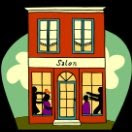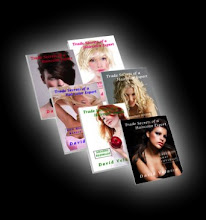 How to Create Successful Single Process Blondes
What do you think of when you envision a beautiful single process blonde?
Do you envision a soft buttery blonde, that has a hint of golden sunshine to it, or an ice cool blonde
that has that Nordic – Swedish look?
These images conjure up thoughts of what I call:
Successful Single Process Blondes.
This is what we think will be achieved when we look at them on the color charts from the manufacturers, but the
reality is usually quite different.
Oranges, blondes, bold gold blondes, brassy blondes, greenish blondes and grayish blondes are
many times what we end up with. And what about the client that you have been
highlighting very heavily for some time now and one day says to you -
“You know I like my blonde highlights so much that I think I want to go solid blonde all over”.
And you figure that maybe she’s right. I mean, if a little blonde looks good, a lot of blonde
should look better. So, you mix your favorite shade of blonde and put it on. In
30 minutes, you have a yellow canary"Book Antiqua"""> sitting in your chair that looks as though she has seen a
ghost. To make matters worse, you suddenly discover the big black bushy
eyebrows that you never realized that she had when the hair was just
highlighted.
All of these situations stated above are just a few of the horrors that can happen when we
start to dive into the world of single process blonding.
To begin with, let’s define the term Single Process Blonding.
When I discuss single process blonde/blonding, I’m referring to one shade of blonde tint (not
lightener, not highlights, not lowlights) that is applied to the hair from re-growth
to ends.
Who are the Best and Worst Candidates for
Single Process Blonding
Like all the haircolor that we do, we’ll always have a best and worst candidate for any
particular shade and single process blonding is no different. As a matter of
fact, this is one category of color where choosing the right candidate is
absolutely essential in order to achieve success. And as you will soon see,
there are very few really good candidates from which to choose.
If you try to make a single process blonde out of anyone that is a natural level 1-6, you are
going to get very warm tones and produce an orange/brassy blonde.
This does not mean, however, that we cannot make them blondes in other ways, such as a double
process blonde or a slightly warm single process blonde with highlights woven
in to defuse the warm tones
That leaves us with natural levels 7, 8, 9, 10.
If you think about it, why would anyone with a natural level 9 or 10 want or need to color her
hair blonde? The only reason that I can think of is if she has gray in her
blonde hair and wants to re-color it blonde.yes""> This will actually be darkening, not lightening, the hair.
So that leaves us with only two natural levels to chose from, 7 & 8. Yes, that’s right,
believe it or not, out of all the people in the world the only clients, in my
opinion, that will become beautiful, successful single process blondes are the
ones that are already starting out with a light natural base color such as
natural levels 7 & 8.
Having said this, here is the exception to this rule - there are a few level 6 clients that you
may be able to make successful single process blondes.
These are clients that have very light color skin tones and light cool eye color such as light
blue, light gray or light green. The light skin tones and light eye color will
usually indicate that they have very light Pheomelanin (red-yellow) color pigmentation and, therefore,
usually will not pull too much gold as you lighten their hair. Go ahead and
give them a try.
That's it for today, have a Great Week!
David
How to Create Successful Single Process Blondes
What do you think of when you envision a beautiful single process blonde?
Do you envision a soft buttery blonde, that has a hint of golden sunshine to it, or an ice cool blonde
that has that Nordic – Swedish look?
These images conjure up thoughts of what I call:
Successful Single Process Blondes.
This is what we think will be achieved when we look at them on the color charts from the manufacturers, but the
reality is usually quite different.
Oranges, blondes, bold gold blondes, brassy blondes, greenish blondes and grayish blondes are
many times what we end up with. And what about the client that you have been
highlighting very heavily for some time now and one day says to you -
“You know I like my blonde highlights so much that I think I want to go solid blonde all over”.
And you figure that maybe she’s right. I mean, if a little blonde looks good, a lot of blonde
should look better. So, you mix your favorite shade of blonde and put it on. In
30 minutes, you have a yellow canary"Book Antiqua"""> sitting in your chair that looks as though she has seen a
ghost. To make matters worse, you suddenly discover the big black bushy
eyebrows that you never realized that she had when the hair was just
highlighted.
All of these situations stated above are just a few of the horrors that can happen when we
start to dive into the world of single process blonding.
To begin with, let’s define the term Single Process Blonding.
When I discuss single process blonde/blonding, I’m referring to one shade of blonde tint (not
lightener, not highlights, not lowlights) that is applied to the hair from re-growth
to ends.
Who are the Best and Worst Candidates for
Single Process Blonding
Like all the haircolor that we do, we’ll always have a best and worst candidate for any
particular shade and single process blonding is no different. As a matter of
fact, this is one category of color where choosing the right candidate is
absolutely essential in order to achieve success. And as you will soon see,
there are very few really good candidates from which to choose.
If you try to make a single process blonde out of anyone that is a natural level 1-6, you are
going to get very warm tones and produce an orange/brassy blonde.
This does not mean, however, that we cannot make them blondes in other ways, such as a double
process blonde or a slightly warm single process blonde with highlights woven
in to defuse the warm tones
That leaves us with natural levels 7, 8, 9, 10.
If you think about it, why would anyone with a natural level 9 or 10 want or need to color her
hair blonde? The only reason that I can think of is if she has gray in her
blonde hair and wants to re-color it blonde.yes""> This will actually be darkening, not lightening, the hair.
So that leaves us with only two natural levels to chose from, 7 & 8. Yes, that’s right,
believe it or not, out of all the people in the world the only clients, in my
opinion, that will become beautiful, successful single process blondes are the
ones that are already starting out with a light natural base color such as
natural levels 7 & 8.
Having said this, here is the exception to this rule - there are a few level 6 clients that you
may be able to make successful single process blondes.
These are clients that have very light color skin tones and light cool eye color such as light
blue, light gray or light green. The light skin tones and light eye color will
usually indicate that they have very light Pheomelanin (red-yellow) color pigmentation and, therefore,
usually will not pull too much gold as you lighten their hair. Go ahead and
give them a try.
That's it for today, have a Great Week!
David
Friday, March 5, 2010
How to Create Successful Single Process Blondes
 How to Create Successful Single Process Blondes
What do you think of when you envision a beautiful single process blonde?
Do you envision a soft buttery blonde, that has a hint of golden sunshine to it, or an ice cool blonde
that has that Nordic – Swedish look?
These images conjure up thoughts of what I call:
Successful Single Process Blondes.
This is what we think will be achieved when we look at them on the color charts from the manufacturers, but the
reality is usually quite different.
Oranges, blondes, bold gold blondes, brassy blondes, greenish blondes and grayish blondes are
many times what we end up with. And what about the client that you have been
highlighting very heavily for some time now and one day says to you -
“You know I like my blonde highlights so much that I think I want to go solid blonde all over”.
And you figure that maybe she’s right. I mean, if a little blonde looks good, a lot of blonde
should look better. So, you mix your favorite shade of blonde and put it on. In
30 minutes, you have a yellow canary"Book Antiqua"""> sitting in your chair that looks as though she has seen a
ghost. To make matters worse, you suddenly discover the big black bushy
eyebrows that you never realized that she had when the hair was just
highlighted.
All of these situations stated above are just a few of the horrors that can happen when we
start to dive into the world of single process blonding.
To begin with, let’s define the term Single Process Blonding.
When I discuss single process blonde/blonding, I’m referring to one shade of blonde tint (not
lightener, not highlights, not lowlights) that is applied to the hair from re-growth
to ends.
Who are the Best and Worst Candidates for
Single Process Blonding
Like all the haircolor that we do, we’ll always have a best and worst candidate for any
particular shade and single process blonding is no different. As a matter of
fact, this is one category of color where choosing the right candidate is
absolutely essential in order to achieve success. And as you will soon see,
there are very few really good candidates from which to choose.
If you try to make a single process blonde out of anyone that is a natural level 1-6, you are
going to get very warm tones and produce an orange/brassy blonde.
This does not mean, however, that we cannot make them blondes in other ways, such as a double
process blonde or a slightly warm single process blonde with highlights woven
in to defuse the warm tones
That leaves us with natural levels 7, 8, 9, 10.
If you think about it, why would anyone with a natural level 9 or 10 want or need to color her
hair blonde? The only reason that I can think of is if she has gray in her
blonde hair and wants to re-color it blonde.yes""> This will actually be darkening, not lightening, the hair.
So that leaves us with only two natural levels to chose from, 7 & 8. Yes, that’s right,
believe it or not, out of all the people in the world the only clients, in my
opinion, that will become beautiful, successful single process blondes are the
ones that are already starting out with a light natural base color such as
natural levels 7 & 8.
Having said this, here is the exception to this rule - there are a few level 6 clients that you
may be able to make successful single process blondes.
These are clients that have very light color skin tones and light cool eye color such as light
blue, light gray or light green. The light skin tones and light eye color will
usually indicate that they have very light Pheomelanin (red-yellow) color pigmentation and, therefore,
usually will not pull too much gold as you lighten their hair. Go ahead and
give them a try.
That's it for today, have a Great Week!
David
How to Create Successful Single Process Blondes
What do you think of when you envision a beautiful single process blonde?
Do you envision a soft buttery blonde, that has a hint of golden sunshine to it, or an ice cool blonde
that has that Nordic – Swedish look?
These images conjure up thoughts of what I call:
Successful Single Process Blondes.
This is what we think will be achieved when we look at them on the color charts from the manufacturers, but the
reality is usually quite different.
Oranges, blondes, bold gold blondes, brassy blondes, greenish blondes and grayish blondes are
many times what we end up with. And what about the client that you have been
highlighting very heavily for some time now and one day says to you -
“You know I like my blonde highlights so much that I think I want to go solid blonde all over”.
And you figure that maybe she’s right. I mean, if a little blonde looks good, a lot of blonde
should look better. So, you mix your favorite shade of blonde and put it on. In
30 minutes, you have a yellow canary"Book Antiqua"""> sitting in your chair that looks as though she has seen a
ghost. To make matters worse, you suddenly discover the big black bushy
eyebrows that you never realized that she had when the hair was just
highlighted.
All of these situations stated above are just a few of the horrors that can happen when we
start to dive into the world of single process blonding.
To begin with, let’s define the term Single Process Blonding.
When I discuss single process blonde/blonding, I’m referring to one shade of blonde tint (not
lightener, not highlights, not lowlights) that is applied to the hair from re-growth
to ends.
Who are the Best and Worst Candidates for
Single Process Blonding
Like all the haircolor that we do, we’ll always have a best and worst candidate for any
particular shade and single process blonding is no different. As a matter of
fact, this is one category of color where choosing the right candidate is
absolutely essential in order to achieve success. And as you will soon see,
there are very few really good candidates from which to choose.
If you try to make a single process blonde out of anyone that is a natural level 1-6, you are
going to get very warm tones and produce an orange/brassy blonde.
This does not mean, however, that we cannot make them blondes in other ways, such as a double
process blonde or a slightly warm single process blonde with highlights woven
in to defuse the warm tones
That leaves us with natural levels 7, 8, 9, 10.
If you think about it, why would anyone with a natural level 9 or 10 want or need to color her
hair blonde? The only reason that I can think of is if she has gray in her
blonde hair and wants to re-color it blonde.yes""> This will actually be darkening, not lightening, the hair.
So that leaves us with only two natural levels to chose from, 7 & 8. Yes, that’s right,
believe it or not, out of all the people in the world the only clients, in my
opinion, that will become beautiful, successful single process blondes are the
ones that are already starting out with a light natural base color such as
natural levels 7 & 8.
Having said this, here is the exception to this rule - there are a few level 6 clients that you
may be able to make successful single process blondes.
These are clients that have very light color skin tones and light cool eye color such as light
blue, light gray or light green. The light skin tones and light eye color will
usually indicate that they have very light Pheomelanin (red-yellow) color pigmentation and, therefore,
usually will not pull too much gold as you lighten their hair. Go ahead and
give them a try.
That's it for today, have a Great Week!
David
Subscribe to:
Post Comments (Atom)









No comments:
Post a Comment